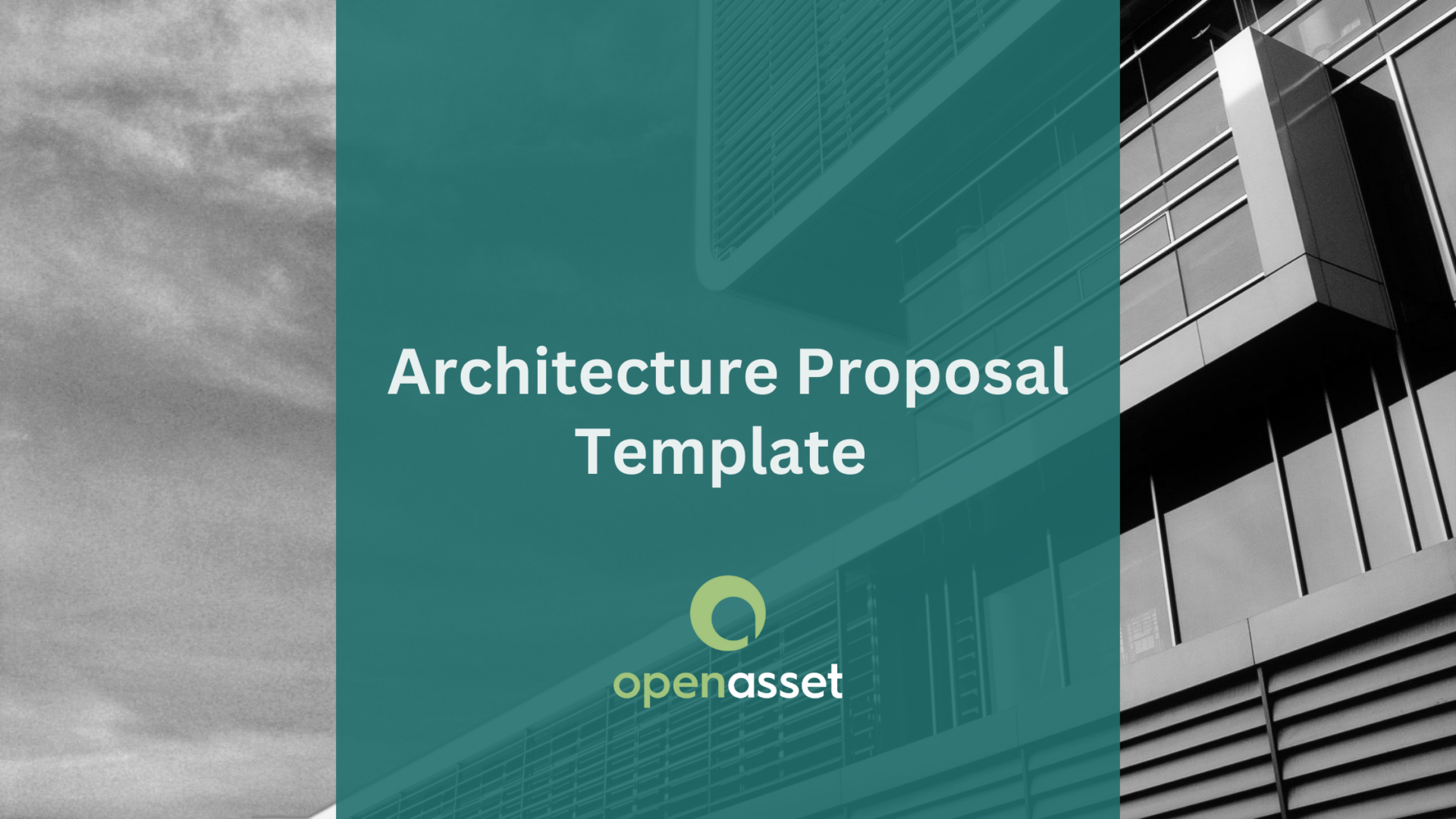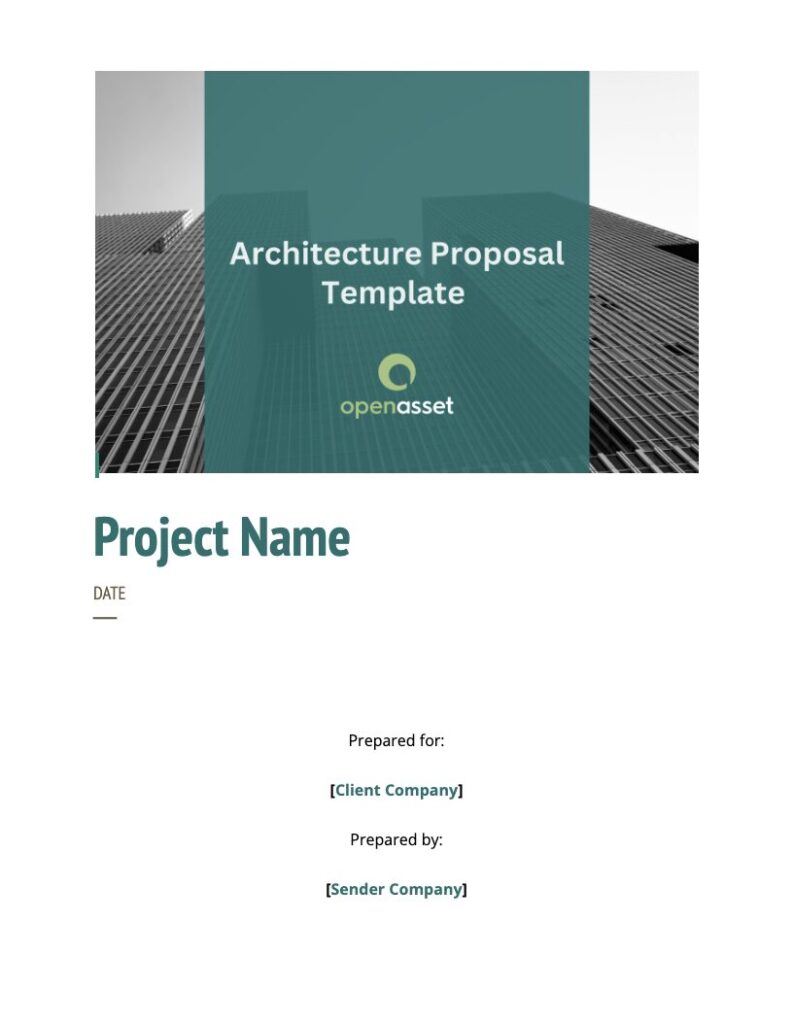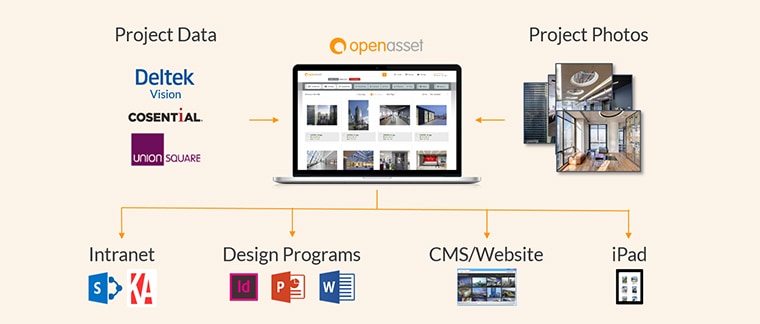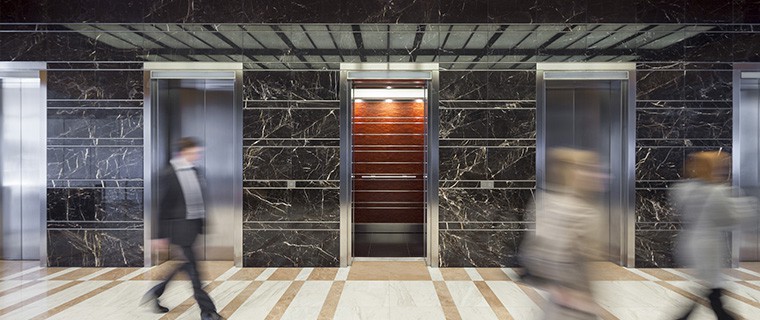Free Architecture Proposal Template: Win More Work
Feb 9, 2024

Architects play a pivotal role in shaping the built environment, and an effective proposal serves as a cornerstone for translating creative ideas into tangible projects. As the only DAM solution for the built world, we understand the impact of having a well-structured architecture proposal template, allowing architects to win more projects and grow their businesses.
With architecture proposal templates, you can create high-quality proposals in no time. With just a few clicks, individuals within your organization, regardless of their design expertise, can effortlessly generate customized, visually appealing materials within seconds. In this blog, we’ll provide insights on creating winning proposals and include a downloadable template.

Importance of Architecture Proposals
If you’re part of the AEC industry, you are likely familiar with RFPs and proposals. You understand the critical role that proposals play in the business development process and the considerable amount of time and effort required to craft them.
A design proposal in architecture refers to a comprehensive document that outlines the vision, concept, and approach for a specific architectural project. It serves as a formal presentation of ideas, solutions, and design strategies to clients, stakeholders, or decision-makers.
Design Proposal Qualities
The design proposal encompasses various elements such as graphics, sketches, drawings, renderings, written descriptions, and specifications, all aimed at communicating the architect’s vision and demonstrating the proposed design’s value and feasibility. It helps facilitate understanding, collaboration, and decision-making processes, ultimately guiding the design and development of the architectural project.
The purpose of design proposals is typically the following:
- Ensure feasibility within the proposed budget and timeframe.
- Provide comprehensive and informative documentation.
- Possess aesthetic appeal, considering the visual and artistic aspects of the design.
- Comply with planning regulations and other relevant legal requirements.
- Demonstrate practicality and viability from technical, social, and economic perspectives, making the design buildable.
- Fulfill the client’s requirements, encompassing aspects such as energy efficiency, security, privacy, safety, comfort, and more.
Types of Architecture Proposals
There are two main types of architectural proposals to note: letter proposals and request for proposal or RFP. Here are the distinct differences between each proposal type.
Letter Proposals
A letter proposal is a concise and persuasive letter written by a company or individual to present a specific idea, project, or service to a potential client or partner. Letter proposals typically outline the key benefits, costs, and terms of the proposal concisely. While a letter proposal is more informal and focuses on selling a particular concept, it should not be created or viewed in the same way as an RFP.
Request for Proposal (RFP)
In comparison to other architectural proposals, a request for proposal (RFP) involves a more formal and intricate process. The RFP outlines specific guidelines for submitting an architectural proposal, with each client having unique requirements. When dealing with RFPs, one can anticipate increased competition and the need to highlight qualifications. It becomes essential to emphasize marketing strategies to promote the firm to the client effectively. Clients can get 30+ RFP responses, so making sure to stand out from the others should be top of mind.
Due to varying client requests, every proposal will possess a unique appearance. However, they should all incorporate similar components. By maintaining a record of successful proposals, you can access valuable templates that enable the efficient creation of winning architecture proposals in the future.
1. Pre-Qualification Process
The pre-qualification process is your architecture firm’s gateway to securing potential projects. This critical phase involves clients evaluating whether your firm’s capabilities align with their project requirements. To navigate this effectively, it’s essential to understand the criteria that clients prioritize, such as financial stability, previous project experience, and technical capabilities.
Highlighting your firm’s strengths and differentiators early on can set the foundation for a successful bid. Provide tangible evidence of your past successes, certifications, and awards to build a compelling case for why your firm should be considered. Remember, the goal is to not just meet the basic qualifications but to stand out as the best fit for the project.
2. Architect’s Qualification Statement
This is your firm’s cover letter and resume. Your Architect’s Qualification Statement is more than just a formality; it’s a powerful tool to showcase the architect’s skills, philosophy, and achievements. This document should also articulate your firm’s approach to design, your commitment to sustainability, and your ability to solve complex architectural challenges.
Include concise case studies or project highlights that demonstrate your expertise in areas relevant to the prospective client’s needs. A well-crafted qualification statement not only provides a solid overview of your team’s capabilities but also sets the tone for the detailed proposal to follow.
3. Technical Proposal
This is where your firm’s expertise and creative vision shine. This comprehensive document should address all aspects of the project, from conceptual design to materials, construction methodologies, and sustainability measures.
Begin with an executive summary that demonstrates your understanding of the project, your design philosophy, and how you intend to meet or exceed the client’s expectations. Follow this with detailed sections on your proposed solutions, highlighting innovation and efficiency.
Additionally, use visuals like diagrams, sketches, and renderings to enhance your narrative. Then, outline your project management strategy, including timelines, budget estimates, and risk mitigation measures. A robust technical proposal demonstrates your firm’s capacity to deliver a project that is not only aesthetically pleasing but also feasible and sustainable.
4. Shortlist Presentation
Lastly, clients could ask for a Shortlist Presentation. At this stage, you’re usually up against two to four rival firms. You’ll be invited to showcase your proposal to the client, highlighting your team, your credentials, and your methodological approach to the project.
The client will then make an informed decision based on these presentations.
Do Architects Write Proposals?
Yes, architects often write proposals as part of their professional practice. Proposals play a crucial role in securing architectural projects and clients. Architects write proposals to communicate their design concepts, approaches, and qualifications to potential clients or project stakeholders.
These proposals outline the architect’s understanding of:
- The project requirements
- Their proposed design solutions
- Scope of work
- Timeline
- Budget
- Other relevant details
The proposal should also include client testimonials or pictures of case studies to build trust and your firm’s background information to prove your worth. Proposals serve as persuasive documents to showcase the architect’s expertise, creativity, and ability to meet the client’s needs.
How Do You Write an Architecture Proposal?
Crafting visually appealing documents that resonate with customers is an important aspect of securing new business. However, the process itself can be an ongoing challenge because your materials must be well-formatted and customized to meet the specific requirements of your prospects.
This includes highlighting relevant projects and showcasing employees whose expertise aligns with the proposal. These documents must be created repeatedly, and therefore speed is a priority. This leads to the struggle of balancing quality and speed when developing their proposals.
Questions to Consider When Submitting a Proposal
Now, let’s address some of the questions that you may be asking yourself throughout the Architectural RFP process.
Is the Proposal Worth My Time and Resources?
Determining the value of pursuing a proposal requires a careful assessment of how well the project aligns with your firm’s strategic goals, expertise, and long-term objectives. Consider whether the project offers an opportunity for growth, aligns with your areas of specialization, and fits within your current workload and resource capabilities.
Establishing a strategy, like a go/no-go process, can prove extremely helpful when deciding whether or not you should approach a proposal. It’s also important to evaluate the potential for future work with this client and the project’s visibility in the market, which could lead to more opportunities.
Ultimately, the decision should be based on whether the benefits and potential for success outweigh the costs and resource commitment required to develop a compelling proposal.
How Can I Understand the Client’s Needs?
To effectively understand a client’s needs, begin with thorough research on their background, industry, and any prior projects, which will provide initial insights into their preferences and expectations. Carefully review the project brief for specific goals and challenges mentioned by the client, and don’t hesitate to ask clarifying questions—this not only deepens your understanding but also shows your engagement and dedication to fulfilling their vision.
Practicing active listening during discussions can reveal underlying priorities and concerns while analyzing the client’s previous ventures gives clues about their aesthetic and functional preferences.
Ultimately, it’s about taking the time and putting in the effort to completely understand your client’s needs.
What Are the Potential Problems That Can Be Addressed in the Proposal?
To address potential client issues beforehand, focusing on budget management, scope definition, and communication is crucial. By setting a detailed budget with contingencies and clearly defining the project scope from the start, you can mitigate the risks of budget overruns and scope creep. Regularly updating and discussing these aspects with the client ensures expectations remain aligned.
Additionally, establishing strong communication facilitates transparency and timely problem-solving, reducing the likelihood of misunderstandings. Proactively managing these areas means addressing many common challenges before they become problematic, ensuring a smoother project lifecycle, and fostering a stronger client relationship.
How Can I Solve Problems the Client Might Encounter?
Solving problems the client might encounter involves a proactive, strategic approach, emphasizing anticipation, communication, and adaptability. Begin by thoroughly understanding the client’s objectives, constraints, and potential risk factors associated with their project.
This foundational knowledge allows you to anticipate challenges and develop preemptive solutions. Maintain open, transparent communication with the client to quickly identify any issues as they arise and to understand their perspective and priorities.
Adopt a collaborative approach, involving the client in the problem-solving process, which fosters a sense of partnership and shared responsibility for the project’s success.
Fee Structure
Here are different fee structures to consider when crafting a winning proposal:
80/20 Rule
The 80/20 approach to fees, inspired by the Pareto Principle, suggests that 80% of the value you provide to a client can be attributed to 20% of your services. Applying this approach to your fee structure means identifying and focusing on the high-impact services that deliver the most value to your clients and adjusting your fees to reflect this value more accurately.
In practice, this could involve conducting a thorough analysis of your service offerings to determine which aspects are most critical to your client’s success. Once identified, you can structure your fees to highlight the premium value of these key services. This might mean higher fees for services that fall within the critical 20%, acknowledging their outsized impact on project outcomes.
On the other side, for the remaining 80% of services that contribute less directly to the core objectives, fees might be adjusted to reflect their supportive role rather than being primary value drivers.
Why Use This Approach
The benefits of this approach include the potential for higher profitability by focusing on what truly matters to clients and possibly streamlining operations by reducing the emphasis on less impactful services.
Additionally, it positions your firm as specialized and value-driven, appealing to clients who are willing to pay a premium for services that directly contribute to their strategic goals. This approach requires clear communication to justify the fee structure based on the differentiated value provided, ensuring clients understand and appreciate the focus on quality and impact.
When to Use This Approach
By presenting proposals that feature a single fee structure, you risk alienating potential clients who find your rates unaffordable, while simultaneously failing to meet the expectations of those prepared to invest in a higher level of service. This strategy not only accommodates diverse budgets but also taps into the willingness of certain clients to pay more for enhanced services.
Hybrid Proposal Fees
Hybrid proposals position the architect’s fees in a middle ground between a flat fee and a percentage-based fee. Initially, you operate on a fixed rate until the project’s scope and budget are firmly established. After the total construction cost of the project is finalized, your subsequent fee becomes a percentage of this total cost.
Why Use This Approach
Adopting a hybrid fee structure can be an effective way to cater to client’s diverse needs and preferences, combining the predictability of fixed fees with the flexibility of time-and-materials billing to address the complexities of project work.
When to Use This Approach
The hybrid model is particularly useful in projects where the scope is not entirely clear from the outset or is expected to evolve. Specifically, this proposal model is most effective for residential projects or smaller-scale commercial projects.
It offers a balanced solution, giving clients the comfort of knowing part of their costs are fixed while also providing the flexibility to accommodate project dynamics without the need for constant renegotiation of terms.
This approach can lead to higher client satisfaction, as it aligns pricing more closely with the value delivered and the actual work required. It also encourages collaboration and communication, as both parties must stay engaged to manage the project’s scope and budget effectively.
What to Include in an Architectural Proposal
Having a compelling proposal template at your disposal can be a valuable time and energy-saving asset when crafting architecture proposals. Our downloadable architecture proposal template will speed up the proposal creation process so it’s ready in no time.
Your architecture proposal template should include the elements below.
1. Cover Page
The first impression your client will form is based on the visually appealing cover page of your architecture proposal. Architects should incorporate an appealing design on their cover page, whether it be colorful or minimalist. The cover page possesses the ability to captivate a reader’s interest.
2. Table of contents
Including a well-structured table of contents in your business proposal template is a key element for success. It makes your proposal scannable, allowing readers to navigate through the document effortlessly. By incorporating a table of contents, your audience can conveniently review the proposal at their own pace and selectively focus on the sections they consider most significant.
3. Executive Summary
The executive summary should consist of a concise 100-500-word overview, providing a top-down perspective on the key aspects of the proposal. It should offer enough detail to outline the project and capture the reader’s interest, encouraging them to delve further into the architectural proposal.
The executive summary should provide an overview of the comprehensive proposal, introduce the firm, and highlight the expert team involved in the project. Additionally, it should include a summary of the sketches and plans, with some architectural proposals taking advantage of this opportunity to showcase high-resolution images from previous successful projects.
4. Project Description and Approach
In this section, provide a detailed overview of the project, including its scope, objectives, and any unique challenges it presents. Describe your architectural vision and how it aligns with the client’s goals and the project’s context. This should not only cover the aesthetic aspects but also how functional requirements will be met.
Explain your approach to sustainability, innovation, and any methodologies you will employ to address specific project needs. It’s important to convey a clear understanding of the project and how your firm is uniquely equipped to deliver a successful outcome.
5. Proposal and Solution
In this section, you have the opportunity to provide a comprehensive explanation of what you will deliver. Here, you can outline the strategies and approaches that will contribute to the success of the project, offering all the necessary details about the deliverables.
This section encompasses precise measurements and the specific components to be included in the construction, such as comfortable rooms, parking areas, lobbies, elevators, and fire exits. It should also outline the required construction materials, the workforce size, and the overall project cost. It’s essential to present this detailed breakdown of the project in an organized manner for clarity and understanding.
6. Relevant Experience
This section should include information about your firm. This includes your background and your qualifications, and highlighting why you are the top choice compared to your competitors. This is your opportunity to explain what unique qualities and capabilities you have, showcase any awards that validate your expertise, and express why you are the perfect match for fulfilling the client’s architectural requirements.
7. Expert Team
This section should feature the expert team that will collaborate with prospective clients. It should include employee resume documents and relevant experience. This section of an architecture proposal provides the initial opportunity for the client to become acquainted with your team, particularly your key team members.
Moreover, it should include the team members along with their respective roles, showcasing their collective work experience, skill sets, and more. This section is the perfect opportunity to demonstrate your team’s capabilities and make clients feel confident when choosing to work with you.
Want to make this process easier and quicker? Implementing a Digital Asset Management (DAM) system can significantly streamline the creation of customized RFP resumes, making the process quicker and more efficient. Just make sure you choose a DAM equipped with an Employee Module. This feature will let you to store, easily access, and utilize all digital assets linked to individual team members.
Additionally, with the Employee Module, you can handle employee-specific information right within the DAM using customizable fields. This versatility allows for the straightforward storage of any pertinent information in the DAM, eliminating the need for complex setup procedures.
Lastly, this module facilitates the linking of employee details, such as their role and duration of employment, with specific projects. This capability allows for the seamless retrieval of information, enabling you to incorporate both project details and related visuals into employee resumes effortlessly.
8. Timeline
This section covers the construction process and its duration. It involves engaging in discussions with your clients to determine the execution of the work. It is crucial to present a well-defined timeline that outlines each phase of the construction process.
Moreover, incorporating work planning into the proposal timeline is a critical step that demonstrates your firm’s strategic approach to project management and execution. This phase is where you outline the initial planning activities that will set the foundation for the entire project, including the allocation of resources, setting milestones, and defining key deliverables.
Specify the time for each construction phase, ranging from a few months to over a year or even more than two years. Being specific about the timeline is important, as clients and investors are unlikely to invest time, money, and effort into a project without a target completion date.
9. Pricing
The pricing section is frequently the first area of interest for many readers, serving as a crucial juncture where you have the opportunity to outline your pricing options and schedules. This transparency empowers clients to identify and choose the options that best align with their needs and budget, facilitating a smoother decision-making process.
Including information about how the budget and fee structure have been tailored to accommodate different project scales and complexities can further enhance client confidence, demonstrating your firm’s flexibility and commitment to providing value at every level of investment.
10. Terms and Conditions
Lastly, establish clear and mutually beneficial terms and conditions within the proposal. Ensure fairness for both you and your clients by including contract terms, fine print, and signatures in this section. It is important to outline the potential consequences or sanctions if the terms and conditions are not met. The terms and conditions serve as a legal contract that governs the agreement between both parties.
11. Get It Signed
This final section is where you call the client to action, encouraging them to formalize the engagement. Include clear instructions on how to sign the proposal, whether it’s a digital signature or a traditional ink signature. You may also want to outline the next steps post-signature, such as an initial meeting to kick off the project or a timeline for when work will begin.
Moreover, ensure that this section is straightforward, making it as easy as possible for the client to say yes and sign on the dotted line.
Architecture Proposal Template
To save you valuable time, we’ve created an architecture proposal template that will help you win more clients. This template can be edited and used again to accommodate any RFP’s needs.

The Benefits of Architecture Proposal Software
Using Digital Asset Management (DAM) software for creating architecture proposals offers several benefits that streamline the process and enhance the quality of the proposals. Here are some key advantages:
- Efficient Organization and Retrieval: DAM systems allow for the centralized storage of digital assets. This centralization makes it easier to organize, search for, and retrieve assets quickly, saving valuable time during the proposal creation process.
- Improved Collaboration: Teams can access and work on proposal assets simultaneously, regardless of their location. This real-time collaboration ensures that everyone is working with the most up-to-date versions of assets, reducing errors and ensuring consistency across documents.
- Brand Consistency: With DAM software, firms can ensure that all proposal documents adhere to brand guidelines and that updated versions are being used.
- Streamlined Updates and Revisions: Updating proposals is straightforward with DAM software. Instead of searching through various files and folders, team members can quickly locate and update the necessary assets within the DAM, ensuring that proposals are always current and accurate.
- Time and Cost Savings: By reducing the time spent searching for assets, collaborating on documents, and ensuring brand consistency, DAM software can significantly cut down on the hours and resources dedicated to proposal creation. These savings can then be redirected toward other strategic activities.

| TIP: Find out more about the Most Important DAM Features every DAM solution should offer to help you win more business. |
Architectural Proposal FAQs
If you still have unanswered questions about the proposal process for architecture, here are some of the top FAQs to guide you:
How Long Does It Take To Write an Architect Proposal?
According to the RFP statistics, the average time for writing a single RFP response is 32 hours or 25 minutes per question. This excludes the time required to evaluate the RFP, format the responses, or craft the cover letter.
Moreover, 45% of architecture RFPs take about 6–20 days to complete.
What Is an Architecture Proposal?
An architecture proposal is a comprehensive document prepared by architects or architectural firms to outline their design solutions and strategies for a specific project. It serves as a bid or offer to take on a project and includes details such as:
- The project’s scope
- The architectural concept and design approach
- Timeline
- Cost estimates
- The team’s qualifications
- Additional information that demonstrates how the firm plans to meet the client’s needs and objectives
The proposal aims to convince the client that the architect or firm is the best choice for bringing their project to fruition.
Can Architecture Proposals Be Revised After They Have Been Submitted?
Yes, architecture proposals can be revised after submission, especially in response to feedback from the client or changes in project requirements. Revisions might be necessary to address questions, refine the project scope, adjust cost estimates, or update timelines.
However, the ease and extent to which a proposal can be revised often depend on the terms agreed upon during the submission process and the flexibility of the client. Architects need to maintain open lines of communication with clients to facilitate any necessary adjustments.
What Employees Should Be Included in the Proposal Response?
When crafting an architect’s RFP response, select employees depending on the project’s specific demands and the stipulations of the RFP. To ensure the selection of the most appropriate team members for each RFP response, it’s crucial to adhere to the RFP’s instructions. Often, the RFP will detail the specific roles and expertise required for the project.
Typical roles that might be essential to include in your response to an Architecture, Engineering, and Construction (AEC) RFP are:
- Project Manager (PM)
- Architects
- Engineers (including Structural, Mechanical, Electrical, and Civil)
- Construction Manager
Remember, choosing team members should be based on their relevant experience and notable professional accomplishments, focusing on what they can contribute to the project’s success. This strategic selection ensures that your proposal team is ready to meet the RFP’s requirements and showcases the depth of your firm’s expertise and capacity to deliver on the project’s goals.
Start With OpenAsset
Creating compelling proposals is essential to winning clients and securing projects for your architecture firm. However, we recognize the obstacles you may encounter in this process. That’s why OpenAsset offers a project-based Digital Asset Management (DAM) platform designed to assist AEC firms.
Our platform enables you to create documents in seconds with templates and generate high-quality RFP responses efficiently and effortlessly. With a wide range of integrations and valuable top features, OpenAsset serves as the ideal marketing technology solution for creating persuasive content, proposals, presentations, and more.
Get your free sample of our downloadable architecture proposal template today.
And if you’d like to learn more about our DAM technology, you can reach out to our Support team, here or contact one of our digital asset experts today to schedule a demo.





